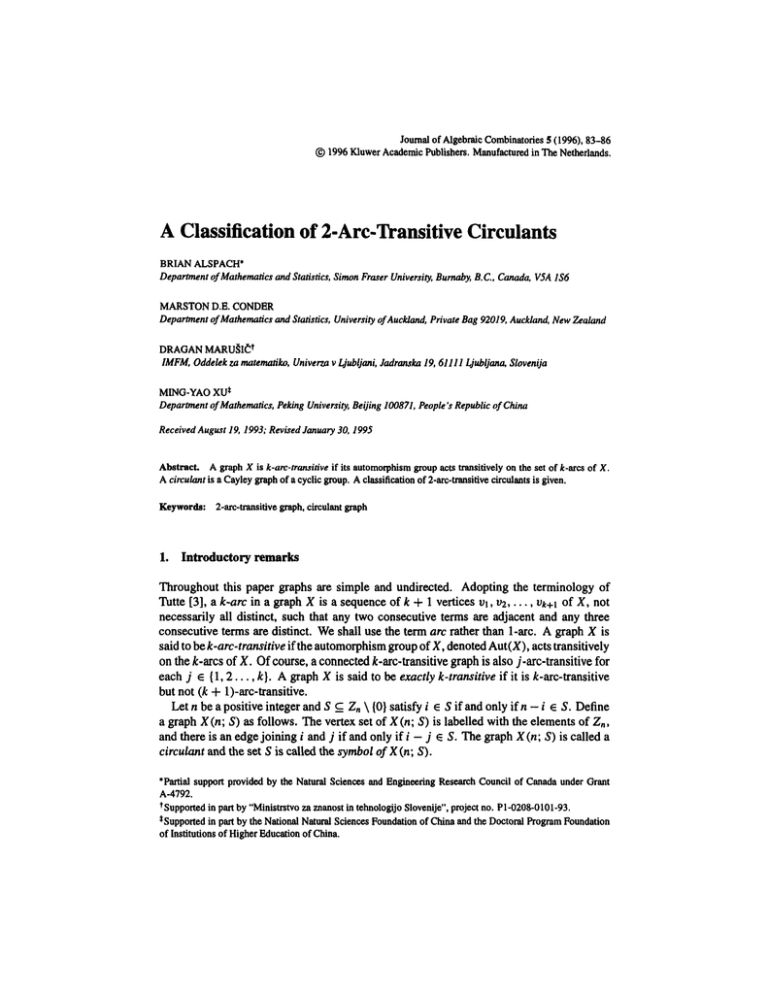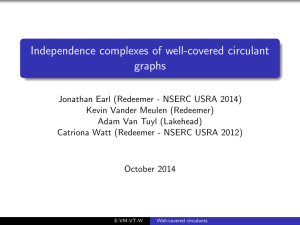Journal of Algebraic Combinatories 5 (1996), 83-86
advertisement

Journal of Algebraic Combinatories 5 (1996), 83-86
© 1996 Kluwer Academic Publishers. Manufactured in The Netherlands.
A Classification of 2-Arc-Transitive Circulants
BRIAN ALSPACH*
Department of Mathematics and Statistics, Simon Fraser University, Burnaby, B.C., Canada, V5A 1S6
MARSTON D.E. CONDER
Department of Mathematics and Statistics, University of Auckland, Private Bag 92019, Auckland, New Zealand
DRAGAN MARUSlC*
IMFM, Oddelek za matematiko, Univerza v Ljubljani, Jadranska 19,61111 Ljubljana, Slovenija
MING-YAO XU*
Department of Mathematics, Peking University, Beijing 100871, People's Republic of China
Received August 19, 1993; Revised January 30,1995
Abstract. A graph X is k-arc-transitive if its automorphism group acts transitively on the set of it-arcs of X.
A circulant is a Cayley graph of a cyclic group. A classification of 2-arc-transitive circulants is given.
Keywords: 2-arc-transitive graph, circulant graph
1. Introductory remarks
Throughout this paper graphs are simple and undirected. Adopting the terminology of
Tutte [3], a k-arc in a graph X is a sequence of k + 1 vertices v 1 ,v 2 ,..., vk+1 of X, not
necessarily all distinct, such that any two consecutive terms are adjacent and any three
consecutive terms are distinct. We shall use the term arc rather than 1-arc. A graph X is
said to be k-arc-transitive if the automorphism group of X, denoted Aut(X), acts transitively
on the K-arcs of X. Of course, a connected k-arc-transitive graph is also j -arc-transitive for
each j E {1,2 ...,K}. A graph X is said to be exactly k-transitive if it is k-arc-transitive
but not (k + l)-arc-transitive.
Let n be a positive integer and S c Zn \ {0} satisfy i E S if and only if n — i € S. Define
a graph X(n; S) as follows. The vertex set of X(n; 5) is labelled with the elements of Zn,
and there is an edge joining i and j if and only if i — j € S. The graph X (n; 5) is called a
circulant and the set S is called the symbol of X(n;S).
*Partial support provided by the Natural Sciences and Engineering Research Council of Canada under Grant
A-4792.
Supported in part by “Ministrstvo za znanost in tehnologijo Slovenije”, project no. Pl-0208-0101-93.
* Supported in part by the National Natural Sciences Foundation of China and the Doctoral Program Foundation
of Institutions of Higher Education of China.
ALSPACH ET AL.
84
Our long-term goal is to classify all arc-transitive circulants (we use the term arc-transitive
instead of 1-arc-transitive). It is not difficult to see that for any positive integer n and any
even order subgroup S of Zn*, the graph X(n; S) is an arc-transitive circulant. In fact, if
n = p is a prime the above construction exhausts the entire class of arc-transitive circulants
on p vertices (see [1, 2]). With the exception of Cp and Kp, all of the above graphs
are exactly 1-transitive circulants. On the other hand, there are circulants which are 2-arctransitive. As a first step towards our long-term goal, we wish to determine which circulants
are 2-arc-transitive.
The aim of this paper is to prove the following result.
Theorem 1.1 A connected, 2-arc-transitive circulant of order n, n > 3, is one of the
following graphs:
(i) the complete graph Kn, which is exactly 2-transitive;
(ii) the complete bipartite graph Kn/1,n/2, n > 6, which is exactly 3-transitive',
(iii) the complete bipartite graph Kt,i minus a 1-factor, n/2 > 5 odd, which is exactly
2-transitive; and
(iv) the cycle Cn of length n, which is k-arc-transitive for all k > 0.
The proof of this theorem is given in the next section. A few observations about the
preceding theorem are in order. Of course, the cycles are something of an anomaly. They
are the only connected circulants of degree 2 and the conclusion of (iv) is seen easily. This
allows us to assume that all circulants under consideration have degree at least 3. The next
result reduces the analysis to circulants of girth 4.
Proposition 1.2 If X is neither Cn nor Kn and is a connected 2-arc-transitive circulant,
then its girth is 4.
Proof: If X = Cn, then its girth is either 3 or 4. Namely, let S be a symbol of X. For
s1, s2 E S such that s2 = s1, –s1 we have that (0, s1, s1 + s2, s2, 0) is a 4-cycle in X.
Suppose that C3 is a 3-cycle of X. Any path of length 2 on C3 has an edge joining its end
vertices. Since X is 2-arc-transitive, the preceding is true of any path of length 2 in X.
Since X is connected, X must be a complete graph.
D
2.
Proving Theorem 1.1
Let us start out with some of the tools and conventions that go into the proof of Theorem 1.1.
If X is a graph and U and W are disjoint subsets of V (X), we let X[U, W] denote the bipartite
graph induced by the edges of X having one end vertex in U and the other in W. Given
v E V (X) we let N' (v) denote the set of all vertices of X at distance i from v;. In particular,
we let N(v) = N 1 (v). A bipartite graph X with a bipartition (U, W)is said to be biregular if
the degrees of all vertices in U are equal and if the degrees of all vertices in W are equal, too.
Proposition 2.1 Let X be a connected 2-arc-transitive graph and let v E V(X). Then
X[N(v), N2(v)] is biregular.
A CLASSIFICATION OF 2-ARC-TRANSITIVE CIRCULANTS
85
Proof: Let v E V(X). Since X is 2-arc-transitive, it follows that both N(v) and N2(v)
are orbits of the vertex stabilizer Aut(X) u . The result follows.
D
Lemma 2.2 Let R c Zn \ {0} and let j € Zn \ {0}. Let p(j) = \R n (-R + j)\.
Then
(i) j £ 2R implies that p(j) is even;
(ii) j € 2R and n odd imply that p(j) is odd;
(iii) j € 2R and n even imply that p(j) is even when j = 2r for some r e R U (R +n/2)
but otherwise p(j) is odd.
Proof: Note that the elements belonging to the set R U (—R + j) are paired off whenever
j E 2R. Namely, if r = -r' + j E R n (-R + j), then r' = -r + j E R n (-R + j), too.
This proves (i).
So assume that j e 2R. Using the same argument as above, the parity of p(j) now
depends solely on whether the equation j = 2x has one or two solutions in R. The latter
occurs if and only if n is even and the two solutions differ byn/2.In other words when j = 2r
for some r E R n (R +n/2).This proves both (ii) and (iii).
D
Proof of Theorem 1.1: The proof that the transitivities of the graphs in Theorem 1.1 are
as claimed is left to the reader. Also, note that the case K m,m — mK 2 , m > even, is excluded
as such graphs are not circulants. To see this, note that the underlying 2m-cycle acting on
the vertices of a connected bipartite circulant with 2m vertices must interchange the two
bipartition sets. Hence, one bipartition set is the even integers and the other is the odd
integers. This implies that the symbol contains only odd integers implying the degree must
be even. This excludes Km,m — mK 2 .
Let X E {C n , Kn} be a connected 2-arc-transitive circulant of order n with symbol S. Then
n > 6, the degree d = \S\ of X satisfies 2 < d < n — 1, and the girth of X is 4 by Proposition 1.2. Also, as X is connected we have that (S) = Zn. Because of 2-arc-transitivity, each
2-arc of X is contained in the same number q > 0 of 4-cycles. Let s, s' € S, where s = s'.
Considering the 2-arc(s,0,s'), we have that \S n(S+s'-s) \ = \(S+s) n (S+s')\ = q + l
and so
We are going to distinguish two cases.
Case 1. q + 1 is even.
Since 2S C S + S and S = — S, part (ii) of Lemma 2.2 implies that n is even. Moreover,
part (iii) of Lemma 2.2 implies that s e S +n/2for each s e S\{n/2}. Therefore S n (S +n/2)=
0. This implies that | i S for otherwise X would have girth 3. Hence 5 = 5 +n/2.Also,
n/2 € N2(0) and an application of Proposition 2.1 gives us that each vertex in N2(0) has
degree d in X[N(0), N2(0)] and so d|N2(0)| = (d - 1)\N(0)\ from which we infer that
ALSPACH ET AL.
86
|N2 (0)| = d - 1 . More precisely, (S + s)\ {0} = N2(0) for each s € S. Clearly, each
2-arc in X is contained in d — 1 cycles of length 4 which implies that d = q +1. Therefore,
X[N(0), N2(0)] = kq+1,q and so X =Kq+1,q+1=Kn/2,n/2.
Case 2. q + 1 is odd.
Combining Lemma 2.2 and (1) we can deduce that
and moreover if n is even, 5 n (5 + n) = 0. Let us first assume that 0 € 25. Then n
must be even and furthermore n € S. Also, by (2), S + S = 2S and so 5 + s = 2S for
each s e S. Since X has no triangles, we must have that N(0) = S and N2(0) = 2S \ {0}.
It follows that a 2-arc of the form (s, 0, s'), where s, s' € S, is contained in |25 \ {0}| =
|5| - 1 = d - 1 cycles of length 4. Thus d = q + 1 and so X [ N ( 0 ) , N2(0)] = Kq+1,q.
Hence X = Kq+\,9+i = ^§,5Assume now that 0 $ 25. Then we have that (5 + 5) \ {0} = 25 by (2). Since X
has no triangles it follows that N(Q) = 5 and N2(0) = 25. Clearly, 0 e 5 + s for each
s e 5. Using Proposition 2.1, we conclude that for each s e S there exists a unique
s' € S \ [s] such that 2s' £ 5 + s. It follows that the number of 4-cycles containing
the 2-arc (0, s, 2s), where s e 5, must be d — 2 and so |5| = d = q + 2. Hence
X[N(0), N2(0)] = Kq+2,q+2 -(q+ 2)K2.
The regularity of X implies that the set V(X) \ ({0} U N(0) U W2(0)) contains at least
one vertex. Let u € N3(Q). Suppose u has a neighbour y € N2(u) and a neighbour
z & N2(u). Since y has no neighbours, other than u, outside of N(0), the 2-arc (z, u, y) is
in no 4-cycles. We conclude that there is a unique vertex in V(X) \ ({0} U #(0) U JV2(0)).
In particular, n is even and this vertex is | with N2(0) its set of neighbours. Thus, X =
AT,+3.,+3 - (q + 3)^2 = K»,* - \K2.
D
Acknowledgment
The second and third author thank Simon Eraser University for hospitality during the two
visits that led to the completion of this work.
References
1. J.L. Berggren, "An algebraic characterization of symmetric graphs with p points, p an odd prime," Bull.
Austral. Math. Sac. 7 (1972), 131-134.
2. C. Y. Chao, "On the classification of symmetric graphs with a prime number of vertices," Trans. Amer. Math.
Soc. 158 (1971), 247-256.
3. W.T. Tutte, "On the symmetry of cubic graphs," Canad. J. Math. 11 (1959), 61-64.






